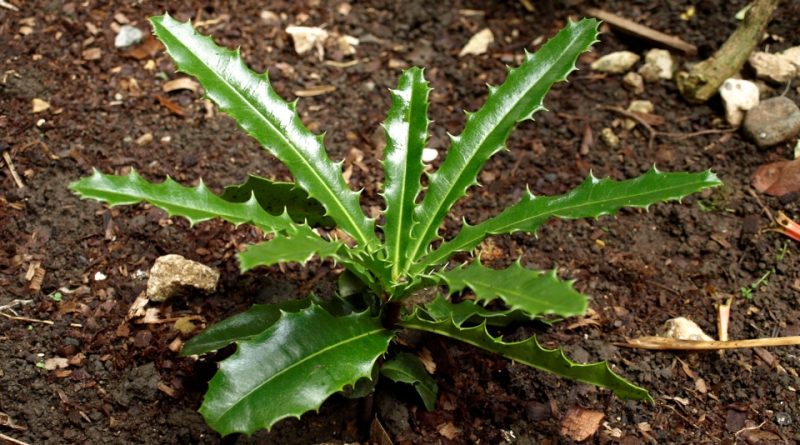Theophrasta jussieui
Theophrasta jussieui
The small coconut (Theophrasta jussieui Lindl., 1821) is a shrub species belonging to the Primulaceae family.
Systematic –
Eukaryota domain
Kingdom Plantae
Division Magnoliophyta
Class Magnoliopsida
Order Primulales
Primulaceae family
Genus Theophrasta,
Species T. jussieui.
The terms are synonymous:
– Theophrasta henrici Gouan, 1825;
– Theophrasta spinosa Willd. ex K. Koch & Fintelm., 1859;
– Theophrasta densiflora Decne., 1876).
Etymology –
The term Theophrasta was given in honor of the Greek philosopher and botanist Θεόϕραστος (in Latin Theophrastus) (ca. 370-ca. 287 BC) considered the father of botany.
The specific epithet jussieui was dedicated to the French botanist Antoine Laurent de Jussieu (1748-1836), known for being the first to publish a natural classification of flowering plants.
Geographic Distribution and Habitat –
Theophrasta jussieui is a plant native to Hispaniola, one of the largest islands of the Antilles, on whose territory the sovereign states of Haiti to the west and the Dominican Republic to the east are located; in this area it is present with few specimens.
Its natural habitat is that of semi-deciduous and evergreen forests, where it grows from sea level up to around 1000 m above sea level.
Description –
Theophrasta jussieui is a shrub with a solitary erect stem, about 5 cm in diameter, brown in colour; on this you can see the trace rings of fallen leaves; it is equipped with spines about 1 cm long and can reach a height of about 2 m.
Above the stem there is a thick crown of leaves, which are carried by a petiole about 0.5 cm long; the leaves are simple, subverticillate, oblong-lanceolate to oblanceolate in shape; they have a generally obtuse apex and a serrated-serrate wavy margin, rigid; they are shiny intense green in color, 20-50 cm long and 5-10 cm wide.
The inflorescences are racemose and produced in the axils of the upper leaves; they are numerous, 5-8 cm long, with 5-6 flowers, on a 3-6 mm long pedicel, white, erect and appressed. The flower has a bell-shaped calyx with 5 ovate lobes, pentagonal corolla with 5 ovate lobes, pentagonal stem crown, short, fleshy, with 5 stamens, bilocular ovate ovary.
The fruit is a globular berry with a somewhat fleshy consistency; it has a yellow color with the presence, when ripe, of small brown spots of 2-4 cm in diameter.
Inside there are numerous seeds measuring 0.6-1 cm in length.
Cultivation –
Theophrasta jussieui is a shrub-like plant that grows mainly in the humid tropical biome.
This plant is practically unknown outside its place of origin. It is found almost exclusively in botanical gardens and specialized collections.
However, due to its ornamental characteristics it could be the subject of greater diffusion.
The plant reproduces by seed; this must be placed in a somewhat draining and aerated substrate, kept constantly humid at a temperature of 26-28 °C.
Customs and Traditions –
Theophrasta jussieui is a plant limited to a rather restricted area in which it is present with few specimens; however it is known by various local names such as: coque Molle, petit coco (Haiti); citro marrón, coco pequeño, guayaba de indio, guayaba de monte, guayaba silvestre (Dominican Republic).
Due to its particular qualities and ornamental characteristics it could be widespread, even outside its range, in humid tropical environments or in protected environments.
Furthermore, it could be widespread in tropical and subtropical gardens, even small ones.
There is not much evidence of this plant, also due to its rarity.
In fact, no particular uses of this plant are known, except that in the past, a flour was obtained from it, obtained from ground seeds and with which a kind of bread was prepared.
Preparation Method –
Theophrasta jussieui is a little-known plant also for its uses, both food and medicinal.
There is information that in the past a kind of bread was prepared using flour obtained from ground seeds.
Guido Bissanti
Sources
– Acta Plantarum – Flora of the Italian Regions.
– Wikipedia, the free encyclopedia.
– GBIF, the Global Biodiversity Information Facility.
– Useful Tropical Plants Database.
– Conti F., Abbate G., Alessandrini A., Blasi C. (ed.), 2005. An annotated checklist of the Italian vascular flora, Palombi Editore.
– Pignatti S., 1982. Flora d’Italia, Edagricole, Bologna.
– Treben M., 2000. Health from the Lord’s Pharmacy, Advice and experiences with medicinal herbs, Ennsthaler Editore.
Photo source:
– https://upload.wikimedia.org/wikipedia/commons/6/67/Theophrasta_jussieui.jpg
– https://upload.wikimedia.org/wikipedia/commons/2/26/26_Theophrasta_jussieui_-_John_Lindley_-_Collectanea_botanica_%281821%29.jpg
Attention: Pharmaceutical applications and food uses are indicated for informational purposes only, they do not represent in any way a medical prescription; we therefore decline any responsibility for their use for healing, aesthetic or food purposes.


